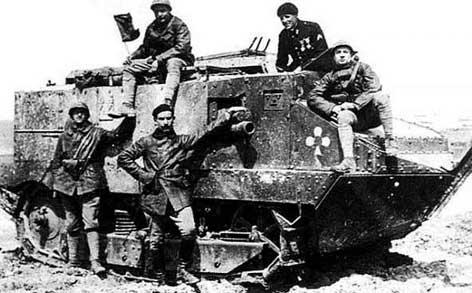"but these tanks are machines, their caterpillars run on as endless as the war, they are annihilation, they roll without feeling into the craters, and climb up again without stopping, a fleet of roaring, smoke-belching armour-clads invulnerable steel beasts squashing the dead and the wounded-we shrivel up in our thin skin before them, against their colossal weight our arms are sticks of straw our hand-grenades matches" (Remarque 282)
The tank was a concept that started in the eighteenth century. In 1770, Richard Edgeworth developed the caterpillar track. Steampowered tractors with caterpillar tracks were used in the Crimean War. In 1885, Holt company made a caterpillar track tractor that had an internal combustion engine. In 1899, Frederick Simms developed a tractor with caterpillar tracks, a bullet proof cased engine and two revolving Maxim machine guns. The British Army rejected it as a "pretty mechanical toy".
The Landship had to be capable of the following jobs:
- minimum speed of 4 miles per hour
- climb a 5 foot high mound
- span a 5 foot wide trench
- small-arms fire bullet proof
- 2 machine guns
- range of 20 miles
- maintained by 10 men
- Carry 3 people, hardly
- top speed 3 miles per hour, 2 mph on rought terrain
- could not cross trenches
In June 1916, the tank was actually war-ready. And on September 15,1916 the British rolled out in their tanks. However, the tanks often got stuck and the men had to escape, running back from the middle of No Man's Land. Also, the heat generated by the tanks was unbearable and the fumes sometimes choked them to death.


The French heard of the Britsh's tank plans and developed their own before the British but did not put them to action until April of 1917. They also were a disappointment.

On the 20 of November, 1917, the British Tank Corps fought in the Battle of Cambrai. They broke through 12 miles of the German front, capturing10,000 POW, 123 guns and 281 machine guns.
On 24 April, 1918, three British Mark IV fought three German A7Vs south og Villers Bretonneux. The British tanks won, pushing back the German tanks.

On August 8, 1918, British tanks advanced 20 miles on the Western Front.
By the end of the war, Britian tank production was out done by the French, who produced 3,870 tanks, against Britian's 2,636. Germany only produced 20 and the US only 84.


No comments:
Post a Comment